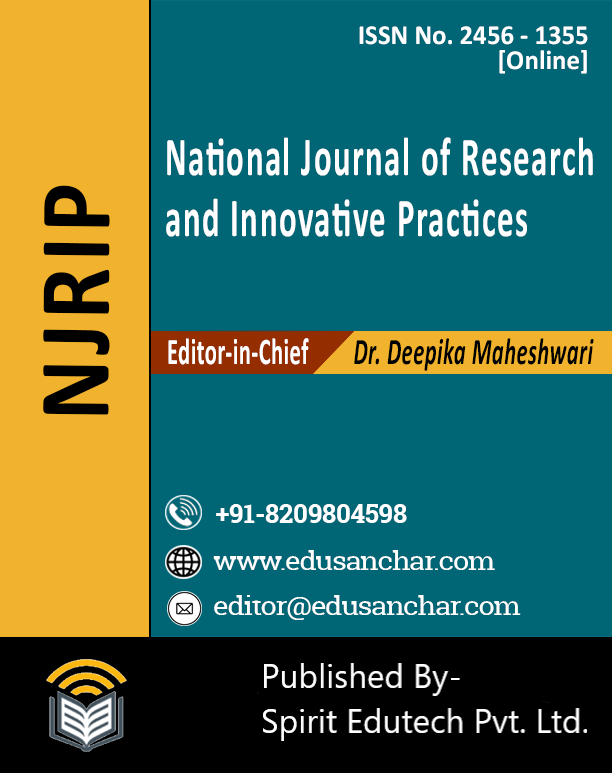
TO STUDY THE IMPACT OF MICROFINANCE INSTITUTIONS ON THE BELOW POVERTY LINE FAMILIES
Author Name :- Akash Bhardwaj,Taruna Bhardwaj,
Journal type:- NJRIP-National Journal of Research and Innovative Practices
Research Field Area :- Commerce and Management ; Volume 3, Issue 1, No. of Pages: 9
Your Research Paper Id :- 20180802
Download Published File :- Click here
Abstraction :-
Keywords :-
Microfinance, credits , farmers, poverty
References :-
1. Malcom Harper, A Training Guide for South Asia: Practical Micro Finance
2. Report, “Status of Microfinance in India ”, NABARD
3. Bindu Ananth,Financing Microfinancial-the ICICI Bank Partnership model, Published in Small
Enterprise Development Vol 16 No.1,March, 2005
4. Harsha Bhargava and Rajeev Sharma, managing corporate Finance: A Corporate Approach.
5. http://www.microfinancegateway.org/p/site/m/
6. http://ifmr.ac.in/
7. http://www.nationmaster.com/index.php
8. http://www.investopedia.com/search/searchresults.aspx?q=microfinance&submit=Search
9. http://www.indiamicrofinance.com/
10. http://www.youtube.com/
11. http://www.microfinanceinsights.com/
12. http://www.kiva.org/
13. http://www.visionfundinternational.org/VisionFund/VisionFundweb.nsf/maindocs/2AF707594FF2A
938882575E100664048?opendocument
14. http://www.facebook.com/microloans?ref=search&sid=1186946393.1488703645..1
15. http://en.wikipedia.org/wiki/Microfinance
16. http://lnweb90.worldbank.org/exteu/SharePapers.nsf/7795535c333f8172c1257162003d5b69/0a0e95
f1471f1d4c852571fd004dae86/$FILE/Alok%20Misra.pdf
17. http://www.scribd.com/doc/15792399/Micro-Finance-Last-Ppt
18. Bhaduri, Amit (1973). “A Study in Agricultural Backwardness under Semi-Feudalism”.
Economic Journal, 83: 120–137.
19. Boudreaux, Karol, and Tyler Cowen (2008). “The Micromagic of Microcredit”. Wilson
Quarterly, Winter.
20. Chowdhury, Anis and Iyantul Islam (1993). The Newly Industrialising Economies of East
Asia. Routledge, London,
21. Daley-Harris, Sam (2007). “Debate on Microcredit”. Foreign Policy in Focus,
http://www.fpif.org/fpiftxt/4324, accessed on Dec. 2, 2008.
22. Dasgupta, Partha (1995). An Inquiry into Well-Being and Destitution. Oxford University
Press, Oxford.
23. Dichter, Thomas (2006). “Hype and Hope: The Worrisome State of the Microcredit
Movement”. The White Man’s Burden: Why the West’s Efforts to Aid the Rest Have Done
So Much Ill and So Little Good. Penguin Press, New York.
24.Hulme, David, and Paul Mosley (1996). Finance Against Poverty. Routledge, London. Huq, Hamidul
(2004) “Surviving in the world of microdebt: A case from rural Bangladesh” in Hotze Lont and Otto
Hospes (eds.) Livelihood and Microfinance, Delft: Eburon.
25. Jain, Pankaj, and Mick Moore (2003). “What makes Microcredit Programme Effective? Fashionable
Fallacies and Workable Realities”. IDS Working Paper 177, Institute of Development Studies,
University of Sussex, Brighton.
26. Jomo K. S. [ed.] (2001). Southeast Asia’s Industrialization: Industrial Policy, Capabilities and
Sustainability. Palgrave, Houndmills.


